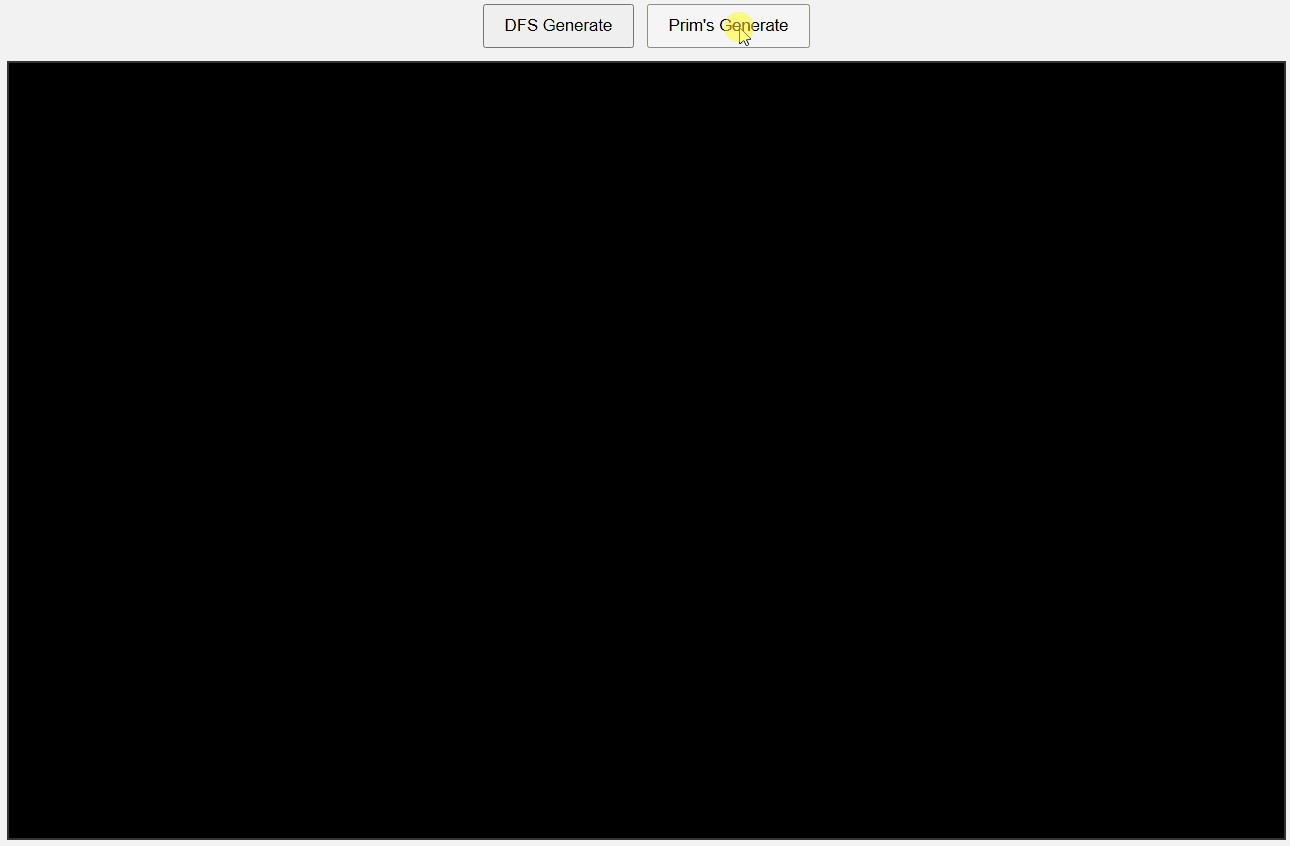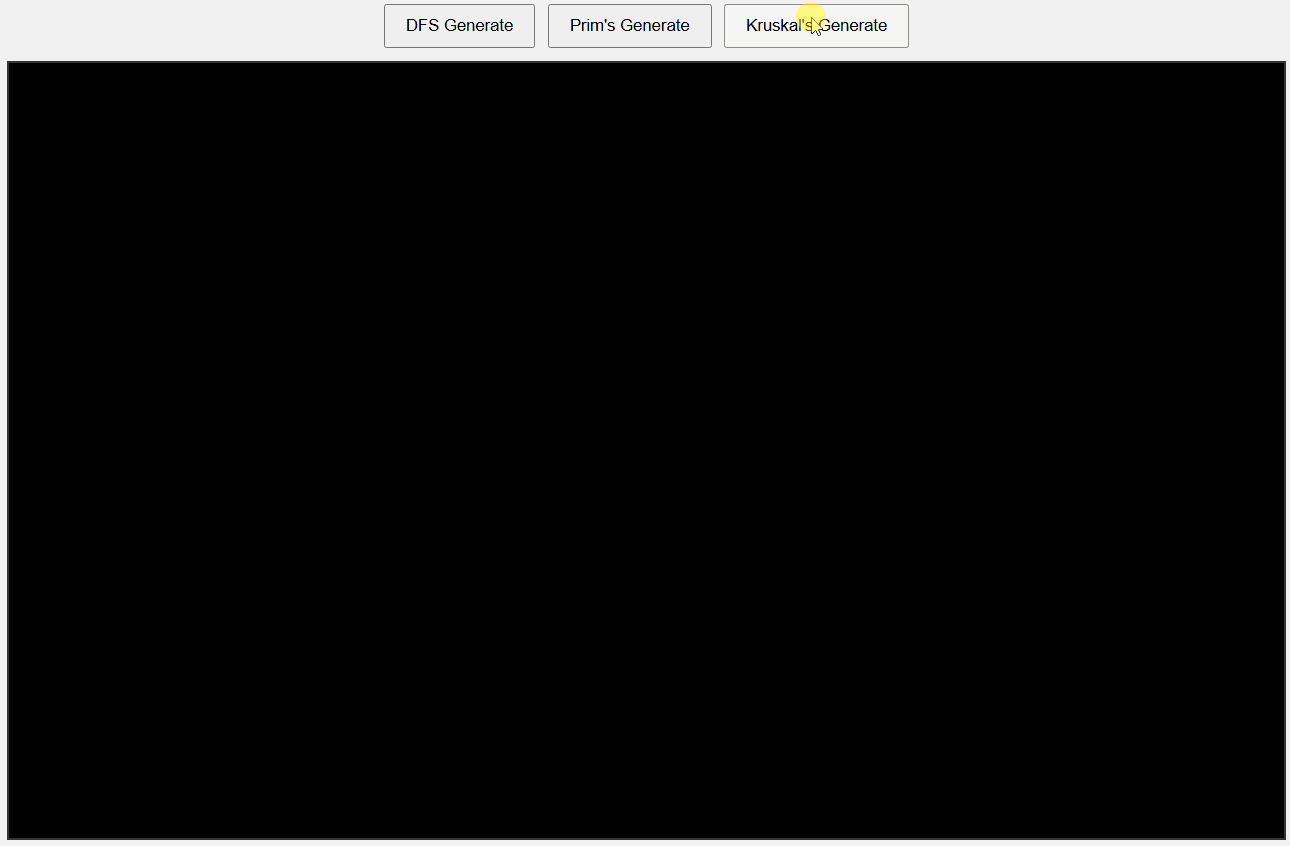미로 생성기 02
개요
Prim’s 알고리즘과 Kruskal’s 알고리즘의 미로를 추가하기
구현
시작 전에 공통으로 사용할 함수를 index로 몰아준다.
1. Prim’s 알고리즘
DFS와 Prim의 미로는 겉으로는 제법 유사해보이는데 Prim은 탈출 경로가 훨씬 단순해진다.
DFS는 한 방향으로 쭈욱 파다가 막히면 돌아가서 새로운 길을 찾는데,
Prim은 미로의 경계에서 새로운 길을 만들기 때문이다.
느낌으로 비교하자면 DFS는 ‘길을 파는 것’이고 Prim은 ‘벽을 뚫는 것’이다.
벽을 뚫는 것이기 때문에 인접한 벽(여기서는 프론티어)을 모아두고 랜덤으로 선택해서 뚫어나간다.
DFS와 마찬가지로 js를 작성하고 기존 html에 스크립트를 추가한다.
// Prim's 알고리즘
async function generatePrim() {
// 시작점 (0,0)
const startX = 0;
const startY = 0;
maze[startY][startX] = 0;
drawCell(startX, startY, 'white');
// 프론티어 셀
const frontiers = [];
const frontierSet = new Set();
addFrontiers(startX, startY, frontiers, frontierSet);
while (frontiers.length > 0) {
// 무작위 프론티어 선택
const randomIndex = Math.floor(Math.random() * frontiers.length);
const [x, y] = frontiers.splice(randomIndex, 1)[0];
frontierSet.delete(`${x},${y}`);
// 인접한 통로 찾기 (경계 포함)
const neighbors = getNeighbors(x, y);
if (neighbors.length === 0) {
// 인접 통로 없으면 무시
continue;
}
// 무작위 인접 통로 선택
const [nx, ny] = neighbors[Math.floor(Math.random() * neighbors.length)];
// 벽 뚫기
const wallX = (x + nx) / 2;
const wallY = (y + ny) / 2;
maze[y][x] = 0;
maze[wallY][wallX] = 0;
drawCell(x, y, 'white');
drawCell(wallX, wallY, 'white');
// 새로운 프론티어 추가
addFrontiers(x, y, frontiers, frontierSet);
await sleep(5);
}
}
// 프론티어 셀 추가 (중복 방지, 경계 포함)
function addFrontiers(x, y, frontiers, frontierSet) {
const dirs = [[0, -2], [2, 0], [0, 2], [-2, 0]];
for (let [dx, dy] of dirs) {
const nx = x + dx;
const ny = y + dy;
const key = `${nx},${ny}`;
if (nx >= 0 && nx < cols && ny >= 0 && ny < rows && maze[ny][nx] === 1 && !frontierSet.has(key)) {
frontiers.push([nx, ny]);
frontierSet.add(key);
}
}
}
// 인접한 통로 찾기 (경계 포함)
function getNeighbors(x, y) {
const neighbors = [];
const dirs = [[0, -2], [2, 0], [0, 2], [-2, 0]];
for (let [dx, dy] of dirs) {
const nx = x + dx;
const ny = y + dy;
if (nx >= 0 && nx < cols && ny >= 0 && ny < rows && maze[ny][nx] === 0) {
neighbors.push([nx, ny]);
}
}
return neighbors;
}
async function startPrim() {
initMaze();
await generatePrim();
// 입구 표시
drawCell(entrance[0], entrance[1], 'lime');
// 가장 먼 곳이 출구
const [ex, ey] = findFurthestCell(entrance[0], entrance[1]);
exit = [ex, ey];
// 출구 표시
drawCell(exit[0], exit[1], 'blue');
const path = findPathBFS(entrance[0], entrance[1], exit[0], exit[1]);
await drawPathAnimated(path);
}
2. Kruskal’s 알고리즘
Kruskal 미로는 벽에 갇힌 통로를 생성해두고 무작위로 벽을 뚫어 통로를 연결하는 방식이다.
복잡도로 따지면 Prim 보다는 복잡하고 DFS보다는 덜 복잡한 느낌이다.
Prim도 벽을 뚫고 Kruskal도 벽을 뚫는데 차이가 있다면
Prim은 현재 통로와 인접한 벽만 뚫어서 확장해 나가는 것이고
Kruskal은 미로 전체 벽에서 무작위로 통로가 합쳐지도록 뚫는 것이다.
그러니 Prim보다 더 복잡해 보일 수 밖에.
// Kruskal's 알고리즘
async function generateKruskal() {
const sets = new Map();
const walls = [];
// 짝수 좌표만 통로로 초기화, 집합 생성
for (let y = 0; y <= rows; y += 2) {
for (let x = 0; x <= cols; x += 2) {
maze[y][x] = 0;
drawCell(x, y, 'white');
sets.set(`${x},${y}`, `${x},${y}`);
}
}
// 통로 사이의 벽만 벽 리스트에 추가
for (let y = 0; y <= rows; y += 2) {
for (let x = 0; x <= cols; x += 2) {
if (x + 2 < cols) {
// 수평 벽
walls.push([x + 1, y, x, y, x + 2, y]);
}
if (y + 2 < rows) {
// 수직 벽
walls.push([x, y + 1, x, y, x, y + 2]);
}
}
}
// 벽을 무작위로 섞기
for (let i = walls.length - 1; i > 0; i--) {
const j = Math.floor(Math.random() * (i + 1));
[walls[i], walls[j]] = [walls[j], walls[i]];
}
// 하나씩 꺼내서 뚫기
for (let [wx, wy, x1, y1, x2, y2] of walls) {
const set1 = findSet(sets, `${x1},${y1}`);
const set2 = findSet(sets, `${x2},${y2}`);
if (set1 !== set2) {
maze[wy][wx] = 0;
drawCell(wx, wy, 'white');
union(sets, set1, set2);
await sleep(5);
}
}
}
// 경로 압축을 위한 집합 찾기
function findSet(sets, key) {
if (sets.get(key) !== key) {
sets.set(key, findSet(sets, sets.get(key)));
}
return sets.get(key);
}
// 집합 합치기
function union(sets, set1, set2) {
sets.forEach((v, k) => {
if (v === set2) {
sets.set(k, set1);
}
});
}
async function startKruskal() {
initMaze();
await generateKruskal();
// 입구 표시
drawCell(entrance[0], entrance[1], 'lime');
const [ex, ey] = findFurthestCell(entrance[0], entrance[1]);
exit = [ex, ey];
// 출구 표시
drawCell(exit[0], exit[1], 'blue');
const path = findPathBFS(entrance[0], entrance[1], exit[0], exit[1]);
await drawPathAnimated(path);
}
완성
Prim’s 알고리즘 미로

Kruskal’s 알고리즘 미로

반성
미로 그려지는게 예쁘다.
가만히 보고 있으면 기분이 좋아진다.
코드 확인
Prim’s
Link to GitHub
Kruskal’s
Link to GitHub